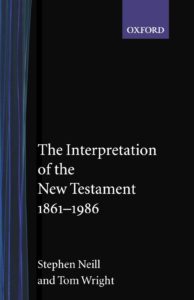 The Interpretation of the New Testament 1861-1986, by Stephen Neill and Tom Wright (Oxford, 1988), 480 pages.
The Interpretation of the New Testament 1861-1986, by Stephen Neill and Tom Wright (Oxford, 1988), 480 pages.
If you are a student of the New Testament, then you should be familiar with the history of interpretation (the helpfulness of which could comprise a post in and of itself). Although we have featured Baird’s volume on the history of research, there are a number of other great resources that may be of interest to you.
One volume I have recently read and enjoyed is Stephen Neill’s ‘The Interpretation of the New Testament 1861-1986’ (nothing like a delayed flight to SBL to get some good reading in!). Neill wrote all but the last chapter, which Wright added. While this volume does, to some extent, presuppose familiarity with the figures and movements in question, it is still accessible to a wide readership.
For those who feel overly familiarly with the common figures in a ‘history’ of interpretation, this volume will give you a number of interesting details. The fact that the author records personal conversations with C. H. Dodd, the legendary study habits of F. C. Baur, and how scholars of the 19th century studied Greek and Hebrew, makes this volume an entertaining read (entertaining for a particular crowd of course). Here is a brief outline of the contents of the book:
I. Challenge to Orthodoxy: traces the rise of 19th c. German theology in the vein of Schleiermacher, Harnack, Strauss, Schweitzer, and F. C. Baur (and with him, the rise of the Tübingen School)
II. The New Testament and History: addresses the 19th c. Cambridge School (Lightfoot, Westcott, Hort), noting their commentaries, contributions and debates. The organization of this chapter is commendable, creating a harmonious narrative for the readership. One particularly interesting point here is the debate surrounding the Clementine writings and letters of Ignatius. Why was this issue such a pivotal dividing line between the Cambridge and Tübingen School? You’ll have to read!
III. What The New Testament Says, And What It Means: This chapter provides a history of, textual criticism (Griesbach, Lachmann, Tregelles, Tischendorf, Westcott, Hort are the focus), philology (Bengal, the Cambridge methodology, Kittle’s ‘Theologisches Wörterbuch zum neuen Testament’, etc), and commentary writing in the 19th c. (the Meyer series of 1832-1852, the work of the Cambridge school, Godet, the Cambridge students [Moule, Caird, McNeile). Due to the targeted nature of study (i.e. specifically 19th c. scholarship) this overview provides greater depth than some of the more expansive histories.
IV. Jesus And The Gospels: is really a chapter about the Synoptic Problem. This chapter is helpful for a number of reasons; chiefly, it provides students/scholars with a resource for the primary texts which have been formative for the modern debate (Lachmann and Weisse on Markan priority, Holtzmann and Harnack on ‘Q’, Streeter’s ‘Four-document Theory’ [M & L]).
V. Greeks and Christians: is a consideration of the influence of all things Greek for the study of the New Testament (Hatch ‘The Influence of Greek Ideas on Christianity’, Grant ‘The Influence of Greek Ideas’, the Oxyrhynchus papyri, mystery religions, magic in the ancient world, Bousset’s theory of historical development, and the ‘History of Religions’ approach).
VI. Re-Enter Theology: surveys the contribution of Albert Schweizter (1875-1965), Karl Barth (1886-1968), Edwin Hoskyns (1884-1937), and Rudolf Bultmann (1884-1976). The remarks regarding Bultmann’s Greek study habits (both Koine and Classical) will rebuke most students of the NT.
VII. The Gospel Behind The Gospels: surveys the rise and main tenants of ‘form criticism’ (focusing on Dibelius). The overarching skepticism among the form critics towards the historical validity and reliability of the various ‘forms’ found in the New Testament, serves as the transition point to discuss the work of Bultmann and Wrede. The distinctiveness of British scholarship (among others) on this point is also noted, namely, Vincent Taylor and C. H. Dodd.
VIII. Salvation Is Of The Jews: introduces the discovery and influence of the Dead Sea Scrolls for the study of the New Testament. Particularly notable is the discussion of the relationship between Qumran and John especially as it relates to the study of the historical Jesus (a field largely neglectful of John’s Gospel), and the work of Bultmann. The section dedicated to the study of the Fourth Gospel is also very helpful. The contributions of Lightfoot (‘Hebrew and Talmudical Exercitations upon the Gospel of St Matthew and St. Mark), Strack-Billerbeck (‘Commentary on the NT from the Talmud’), Edersheim (‘Life and Times of Jesus the Messiah’), Davies (‘Paul and Rabbinic Judaism’), Montefiore (‘Judaism and St. Paul’) are all sufficiently noted and discussed.
IX. History And Theology: this last chapter, written by Wright, highlights a number of key areas of advancement in the 20th c. (understanding religions in antiquity, historical Jesus studies, Pauline theology, the question of Israel, Johannine scholarship). If you don’t buy the book, find it in a university/seminary library and read this final chapter.
Preview or buy it here.


